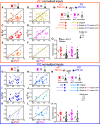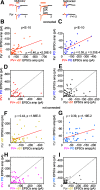Correlated Somatosensory Input in Parvalbumin/Pyramidal Cells in Mouse Motor Cortex
- PMID: 37094939
- PMCID: PMC10167893
- DOI: 10.1523/ENEURO.0488-22.2023
Correlated Somatosensory Input in Parvalbumin/Pyramidal Cells in Mouse Motor Cortex
Abstract
In mammalian cortex, feedforward excitatory connections recruit feedforward inhibition. This is often carried by parvalbumin (PV+) interneurons, which may densely connect to local pyramidal (Pyr) neurons. Whether this inhibition affects all local excitatory cells indiscriminately or is targeted to specific subnetworks is unknown. Here, we test how feedforward inhibition is recruited by using two-channel circuit mapping to excite cortical and thalamic inputs to PV+ interneurons and Pyr neurons to mouse primary vibrissal motor cortex (M1). Single Pyr and PV+ neurons receive input from both cortex and thalamus. Connected pairs of PV+ interneurons and excitatory Pyr neurons receive correlated cortical and thalamic inputs. While PV+ interneurons are more likely to form local connections to Pyr neurons, Pyr neurons are much more likely to form reciprocal connections with PV+ interneurons that inhibit them. This suggests that Pyr and PV ensembles may be organized based on their local and long-range connections, an organization that supports the idea of local subnetworks for signal transduction and processing. Excitatory inputs to M1 can thus target inhibitory networks in a specific pattern which permits recruitment of feedforward inhibition to specific subnetworks within the cortical column.
Keywords: circuit mapping; long-range projections; motor cortex; optogenetic; parvalbumin interneurons; subnetworks.
Copyright © 2023 Goz and Hooks.
Conflict of interest statement
The authors declare no competing financial interests.
Figures








Similar articles
-
Organization of Cortical and Thalamic Input to Inhibitory Neurons in Mouse Motor Cortex.J Neurosci. 2022 Oct 26;42(43):8095-8112. doi: 10.1523/JNEUROSCI.0950-22.2022. Epub 2022 Sep 14. J Neurosci. 2022. PMID: 36104281 Free PMC article.
-
Rapid Disinhibition by Adjustment of PV Intrinsic Excitability during Whisker Map Plasticity in Mouse S1.J Neurosci. 2018 May 16;38(20):4749-4761. doi: 10.1523/JNEUROSCI.3628-17.2018. Epub 2018 Apr 20. J Neurosci. 2018. PMID: 29678876 Free PMC article.
-
The mediodorsal thalamus drives feedforward inhibition in the anterior cingulate cortex via parvalbumin interneurons.J Neurosci. 2015 Apr 8;35(14):5743-53. doi: 10.1523/JNEUROSCI.4565-14.2015. J Neurosci. 2015. PMID: 25855185 Free PMC article.
-
Cortical interneurons: fit for function and fit to function? Evidence from development and evolution.Front Neural Circuits. 2023 May 4;17:1172464. doi: 10.3389/fncir.2023.1172464. eCollection 2023. Front Neural Circuits. 2023. PMID: 37215503 Free PMC article. Review.
-
Control of excitatory hierarchical circuits by parvalbumin-FS basket cells in layer 5 of the frontal cortex: insights for cortical oscillations.J Neurophysiol. 2019 Jun 1;121(6):2222-2236. doi: 10.1152/jn.00778.2018. Epub 2019 Apr 17. J Neurophysiol. 2019. PMID: 30995139 Free PMC article. Review.
Cited by
-
Developmental timecourse of aptitude for motor skill learning in mouse.bioRxiv [Preprint]. 2024 Dec 21:2024.07.19.604309. doi: 10.1101/2024.07.19.604309. bioRxiv. 2024. PMID: 39071410 Free PMC article. Preprint.
References
Publication types
MeSH terms
Substances
Grants and funding
LinkOut - more resources
Full Text Sources
Molecular Biology Databases
